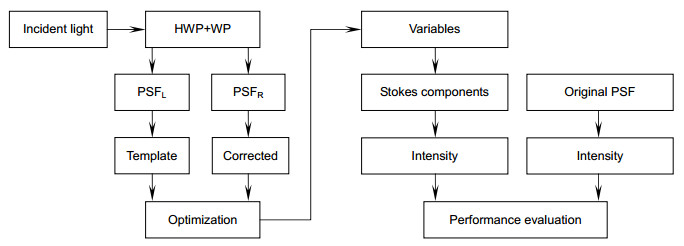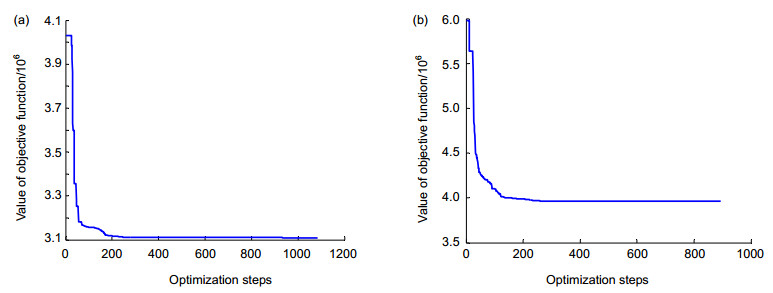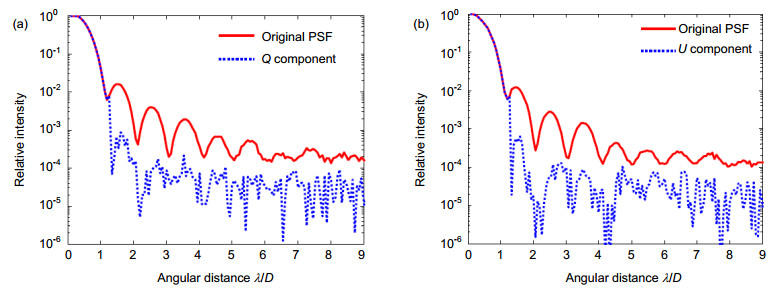| Citation: | Ren Deqing, Yang Chao, Guo Jing, et al. A differential-imaging polarimeter for high-contrast exoplanet imaging[J]. Opto-Electronic Engineering, 2017, 44(11): 1045-1051. doi: 10.3969/j.issn.1003-501X.2017.11.002 |
A differential-imaging polarimeter for high-contrast exoplanet imaging
-
Abstract
Starlight is generally unpolarized, but the light reflected from the planet is linearly polarized as the result of the Rayleigh scattering. For ground-based exoplanet imaging, atmospheres turbulence is changing from time to time, which induces speckle noise and hampers the high-contrast imaging of the faint exoplanets. In this paper, we propose a differential-imaging polarimeter dedicated for exoplanet high-contrast imaging. The system contains a zero-order half-wave plate (HWP) located on the optical pupil plane, which can rotate to modulate the incoming light, and a Wollaston prism (WP) is used to generate two polarized images, which is used for simultaneously polarization differential imaging and thus our system is fundamentally immune to the atmospheric turbulence induced temporally-variable wavefront aberration. Our polarimeter can be inserted near the telescope image focal plane, and provide an extra contrast for the exoplanet high-contrast imaging. To achieve best differential-imaging performance, dedicated algorithm is developed, which can effectively correct the distortion and the intensity unbalance between the two differential images. The system successfully achieves an extra contrast of ~30~50 times, which can be used with current adaptive optics and coronagraph system for directly imaging of giant Jupiter-like exoplanets.
-
Keywords:
- polarimeter /
- high-contrast imaging /
- half-wave plate
-

-
References
[1] Santos N C, Bouchy F, Mayor M, et al. The HARPS survey for southern extra-solar planets II. A 14 Earth-masses exoplanet around μ Arae[J]. Astronomy and Astrophysics, 2004, 426(1): L19-L23. doi: 10.1051/0004-6361:200400076 [2] Narayan R, Cumming A, Lin D N C. Radial velocity detectability of low-mass extrasolar planets in close orbits[J]. The Astrophysical Journal, 2005, 620(2): 1002-1009. [3] Borucki W, Koch D, Batalha N, et al. KEPLER: Search for Earth-size planets in the Habitable Zone[C]//Transiting Planets, Proceedings of the International Astronomical Union, 2009, 253: 289-299. [4] Pepe F, Ehrenreich D, Meyer M R. Instrumentation for the detection and characterization of exoplanets[J]. Nature, 2014, 513(7518): 358-366. [5] Soummer R, Aime C, Falloon P E. Stellar coronagraphy with prolate apodized circular apertures[J]. Astronomy & Astrophysics, 2003, 397(3): 1161-1172. [6] Kasdin N J, Vanderbei R J, Spergel D N, et al. Extrasolar planet finding via optimal apodized-pupil and shaped-pupil coronagraphs[J]. The Astrophysical Journal, 2003, 582(2): 1147-1161. [7] Guyon O, Pluzhnik E A, Kuchner M J, et al. Theoretical limits on extrasolar terrestrial planet detection with coronagraphs[J]. Astrophysical Journal Supplement Series, 2006, 167(1): 81-99. doi: 10.1086/apjs.2006.167.issue-1 [8] Bordé P J, Traub W A. High-contrast imaging from space: speckle nulling in a low-aberration regime[J]. The Astrophysical Journal, 2006, 638(1): 488-498. [9] Ren D Q, Zhu Y T. A coronagraph based on stepped-transmission filters[J]. Publications of the Astronomical Society of the Pacific, 2007, 119(859): 1063-1068. [10] Liu C C, Ren D Q, Dou J P, et al. A high-contrast coronagraph for direct imaging of Earth-like exoplanets: design and test[J]. Research in Astronomy and Astrophysics, 2015, 15(3): 453-460. [11] Dou J P, Ren D Q. Phase quantization study of spatial light modulator for extreme high contrast imaging[J]. The Astrophysical Journal, 2016, 832(84): 1-11. [12] Trauger J T, Traub, W A. A laboratory demonstration of the capability to image an Earth-like extrasolar planet[J]. Nature, 2007, 446(7137): 771-773. [13] Kay J D, Pueyo L A, Kasdin N J. Demonstration of a symmetric dark hole with astroke-minimizing correction algorithm[J]. Proceedings of SPIE, 2009, 7209: 72090G. [14] McBride J, Graham J R, Macintosh B, et al. Experimental design for the Gemini planet imager[J]. Publications of the Astronomical Society of the Pacific, 2011, 123: 692-708. [15] Seager S, Whitney B A, Sasselov D D. Photometric light curves and polarization of close-in extrasolar giant planets[J]. The Astrophysical Journal, 2000, 540(1): 504-520. [16] Saar S H, Seager S. Uses of linear polarization as a probe of extrasolar planet atmospheres[C]//ASP Conference Series, 2003, 294: 529-534. [17] Stam D M, Hovenier J W, Waters L B F M. Using polarimetry to detect and characterize Jupiter-like extrasolar planets[J]. Astronomy & Astrophysics, 2004, 428(2): 663-672. [18] Berdyugina S V, Berdyugin A, Fluri D M, et al. Polarized reflected light from the exoplanet HD 189733b: first multicolor observations and confirmation of detection[J]. The Astrophysical Journal Letters, 2011, 728(1): L6. [19] Hough J H, Lucas P W, Bailey J A, et al. PlanetPol: a very high sensitivity polarimeter[J]. Publications of the Astronomical Society of the Pacific, 2006, 118(847): 1302-1318. doi: 10.1086/pasp.2006.118.issue-847 [20] Perrin M D, Graham J R, Lloyd J P. The IRCAL polarimeter: design, calibration, and data reduction for an adaptive optics imaging polarimeter[J]. Publications of the Astronomical Society of the Pacific, 2008, 120(867): 555-570. [21] Hinkley S, Oppenheimer B R, Soummer R, et al. Speckle suppression through dual imaging polarimetry, and a ground-based image of the HR 4796A circumstellar disk[J]. The Astrophysical Journal, 2009, 701(1): 804-810. [22] Perrin M D, Graham J R, Larkin J E, et al. Imaging polarimetry with the Gemini planet imager[J]. Proceedings of SPIE, 2010, 7736: 77365R. [23] Dou J P, Ren D Q, Zhu Y T, et al. Laboratory test of a polarimetry imaging subtraction system for the high-contrast imaging[J]. Proceedings of SPIE, 2012, 8446: 84468D. [24] Liu C C, Ren D Q, Zhu Y T, et al. A high-contrast imaging polarimeter with a stepped-transmission filter based coronagraph[J]. Research in Astronomy and Astrophysics, 2016, 16(5): 27-32. [25] Roelfsema R, Schmid H M, Pragt J, et al. The ZIMPOL high-contrast imaging polarimeter for SPHERE: design, manufacturing, and testing[J]. Proceedings of SPIE, 2010, 7735: 77354B. [26] Perrin M D, Duchene G, Fitzgerald M P, et al. Gemini planet imager polarimetry of the circumstellar ring around HR 4796A[C]// American Astronomical Society, 2015, 225: 330. 05. [27] Burrows A. A theoretical look at the direct detection of giant planets outside the Solar System[J]. Nature, 2005, 433(7023): 261-268. doi: 10.1038/nature03244 [28] Burrows A, Sudarsky D, Hubeny I. Spectra and diagnostics for the direct detection of wide-separation extrasolar giant planets[J]. The Astrophysical Journal, 2004, 609(1): 407-416. [29] Macintosh B A, Anthony A, Atwood J, et al. The Gemini Planet Imager: integration and status[J]. Proceedings of SPIE, 2012, 8446: 84461U. [30] Carbillet M, Bendjoya P, Abe L, et al. Apodized Lyot coronagraph for SPHERE/VLT. I. Detailed numerical study[J]. Experimental Astronomy, 2011, 30(1): 39-58. [31] Currie T, Guyon O, Martinache F, et al. The Subaru coronagraphic extreme adaptive optics imager: first results and on-aky performance[C]//Proceedings of the International Astronomical Union, 2013, 299: 1307. [32] Macintosh B A, Graham J R, Palmer D W, et al. The Gemini Planet Imager: from science to design to construction[J]. Proceedings of SPIE, 2008, 7015: 701518. doi: 10.1117/12.788083 [33] Martinez P, Carpentier E A, Kasper M. Laboratory demonstration of efficient XAO Coronagraphy in the context of SPHERE[J]. Publications of the Astronomical Society of the Pacific, 2010, 122: 916-923. doi: 10.1086/653442 [34] Wang X, Ren D Q, Dou J P, et al. A dual-channel imaging polarimetry system[J]. Proceedings of SPIE, 2011, 8197: 81971I. doi: 10.1117/12.916664 [35] Dou J P, Ren D Q, Zhu Y T, et al. A demonstration test of the dual-beam polarimetry differential imaging system for the high-contrast observation[J]. Proceedings of SPIE, 2012, 8446: 84461X. doi: 10.1117/12.924246 [36] Weng J, Cohen P, Herniou M. Camera calibration with distortion models and accuracy evaluation[J]. IEEE Transactions on Pattern Analysis and Machine Intelligence, 1992, 14(10): 965-980. doi: 10.1109/34.159901 [37] Tamaki T, Yamamura T, Ohnishi N. Correcting distortion of image by image registration[J]. International Journal of Image and Graphics, 2002, 2(2): 309-329. [38] El-Melegy M T, Farag A A. Nonmetric lens distortion calibration: closed-form solution, robust estimation and model selection[C]//Ninth IEEE International Conference on Computer Vision, 2003, Nice, France, France: IEEE 2003, 2: 554-559. [39] Macintosh B A, Anthony A, Atwood J, et al. The Gemini planet imager: first light and commissioning[J]. Proceedings of SPIE, 2014, 9148: 91480J. [40] Canovas H, Rodenhuis M, Jeffers S V, et al. Data-reduction techniques for high-contrast imaging polarimetry Applications to ExPo[J]. Astronomy & Astrophysics, 2011, 531: A102. -
Overview

For ground-based exoplanet imaging, atmosphere turbulence is changing from time to time, which induces speckle noise and hampers the high-contrast imaging of the faint exoplanets. We propose a differential-imaging polarimeter dedicated for exoplanet high-contrast imaging. The system contains a zero-order half-wave plate (HWP) located on the optical pupil plane, which can rotate to modulate the incoming light, and a Wollaston prism (WP) is used to generate two polarized images, which is used for simultaneously polarization differential imaging and thus our system is fundamentally immune to the atmospheric turbulence induced temporally-variable wavefront aberration. For the star image is much brighter than that of the exoplanet, the exoplanet image cannot be seen before the polarimeter. Since starlight is in generally unpolarized, while exoplanet light is somehow polarized, we focus our discussions on the subtraction of the on-axis starlight, which will automatically result in an extraction of the polarized exoplanet light. However, the direction subtraction of the left side and right side image cannot yield a good result. For example, the intensity difference in both side beams limits the performance of such subtraction. In addition, the image distortion, which will result in a difference for the star point spread functions (PSFs) on both sides, will also seriously limit the subtraction. Therefore, in order to achieve best differential-imaging performance, we also propose an eight-variable optimization algorithm, which is proven to be able to effectively correct the distortion and the intensity unbalance between the two differential images. Laboratory experiments indicate that the proposed polarimeter combined with the optimization algorithm successfully achieves an extra contrast of about 30~50 times in a close angular distance in the region of 3λ/D~5λ/D, and the contrast improvement throughout the region of small angular distance by the polarimeter is apparent. The experimental results demonstrate that our polarimeter works well for both perpendicular polarization components. In conclusion, our polarimeter has the following advantages: 1) The system is simple and compact, which is different from the traditional polarimeter that employs the mechanical modulation approach; 2) Image distortion and intensity unbalance are considered and optimized for best contrast performance; 3) Most important, each polarization component is measurement simultaneously, which is fundamentally immune to the rapidly-changed atmospheric turbulence induced speckle noise. The work is demonstrated to be a promising technique, since our polarimeter has the potential to achieve an overall contrast better than 10-8 when used with current extreme adaptive optics and coronagraph systems, and such work is critical to achieve the scientific goal toward the direct imaging of giant Jupiter-like exoplanets for a ground-based telescope.
-
Access History

-
Figure 1.
Schematic of the working principle of the differential-imaging polarimeter.
-
Figure 2.
Experimental setup of the differential-imaging polarimeter. PH: pinhole. FS: field stop. C: collimator lens. HWP: half-wave plate. WP: Wollaston prism. R: re-imaging lens. CCD: charge-coupled device.
-
Figure 3.
Flow chart of the experiment.
-
Figure 4.
Measured intensities in logarithmic coordinates. (a) HWP@0° for the Q component. (b) HWP@22.5° for the U component.
-
Figure 5.
Optimization curve. (a) Value of objective function of the Q component. (b) Value of objective function of the U component.
-
Figure 6.
Intensity comparisons. (a) The original PSF and Q component. (b) The original PSF and U component.

 E-mail Alert
E-mail Alert RSS
RSS



 DownLoad:
DownLoad:







